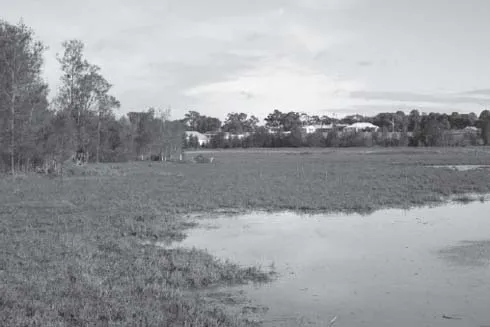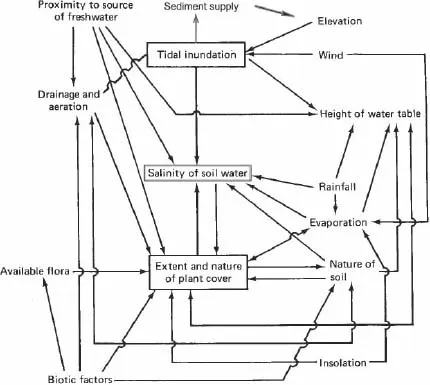![]()
CHAPTER 1
Australian saltmarshes in global context
Paul Adam
Introduction
Coastal saltmarshes are recognised globally as ecosystems of high ecological value which are increasingly under threat (Adam 2002; Valiela 2006). While there is increasing acknowledgement of their importance in Australia, and their ‘Cinderella’ status, demonstrated by Fairweather (1990), has improved over more recent times, they are still relatively unknown compared with the intensively studied marshes of Europe and North America.
Coastal saltmarshes can be defined as intertidal communities dominated by flowering plants, principally herbs and low shrubs. They are found on soft substrate shores of estuaries and embayments, and on some open low wave energy coasts. Coastal saltmarsh is also found on the shores of intermittently open saline coastal lagoons. When these lagoons are open to the sea they are tidal (although tidal amplitude may be attenuated in comparison to nearby open shores), but when closed, which is often the majority of times, water level fluctuations are climate driven and lack predictable periodicity.
Saltmarsh is distinguished from adjacent communities by both floristic composition and structure. Mangroves are dominated by trees (and amongst the world’s forests are unusual in the virtual absence of an understorey). The boundary between saltmarsh and mangrove is normally sharp, but on temperate coasts there are sites with mosaics of saltmarsh and mangrove where there are groves of Avicennia marina interspersed amongst saltmarsh and at the southern global limit of mangroves in Victoria mangroves are stunted and may be lower than the chenopod shrub Tecticornia arbuscula on adjacent saltmarsh. Seagrass beds are predominantly subtidal and are dominated by various monocots (although none are true grasses). The upper limit of saltmarsh is set by the level of the highest tide, but the nature of the transition to terrestrial vegetation will be determined by topography, and, in urban areas, human activity. Coastal lowlands have been very heavily modified in temperate and subtropical regions, so that natural transitions to terrestrial vegetation are becoming uncommon (Figure 1.1). Swamp forests on coastal flood plains often have an understorey of saltmarshes in the transition zone, which may be inundated with brackish water during storms.
Species found in intertidal saltmarsh are also characteristic of seepage zones on seacliffs and rock platforms above the tidal limit, and on some of the most exposed cliffs and headlands, extensive swards (covering hectares) of saltmarsh species are found tens of metres above the sea but subject to high inputs of aerosolic salt.
Australia has very extensive areas of saline soil inland – some of these are of natural origin, but salinisation of agricultural and urban land is one of the major environmental problems to be addressed as a national priority. Some of the species of inland saline areas also occur in coastal saltmarshes, but the majority of the vegetation comprises species in the same genera as those on the coast, but endemic to the inland. At various geological times parts of the inland would have been shallow seas, and, at others, seed transporting birds could have carried propagules between the coast and inland, so that there will have been ample opportunity for gene and species exchange, as well as periods of isolation of local populations and opportunities for speciation.
Figure 1.1 Temperate saltmarsh. Newington, Parramatta River NSW. Marsh dominated by Sarcocornia quinqueflora, and fringing stand of Casuarina glauca.
Towards the head of estuaries, conditions may be brackish or fresh, but still subject to tidal influence. Fringing reed and tall sedge communities in the freshwater tidal zone have been very heavily impacted by urban and agricultural development, and by hydrological change as upstream water abstraction reduces freshwater input. There have been few studies of freshwater tidal marshes in Australia.
In tropical Australia the upper intertidal, flooded by the tides only infrequently, develops hypersalinity during the dry season. The vascular vegetation of these hypersaline flats is extremely sparse and contains only a small number of mostly succulent species (Batis argillicola, Cressa cretica, Sesuvium portulacastrum and Tecticornia australasica). Although the vascular plant cover is very low, there is a skin of microalgae and cynobacteria amongst the salt crust and extending some millimeters into the underlying sediment. The ecology of these flats has not been extensively studied, but they may make a considerable contribution to estuarine productivity; around the Gulf of Carpentaria considerable quantities of salt and nutrients are released from hypersaline flats during king tides (Ridd et al. 1988).
Similar extensive hypersaline flats occur on arid coastal zones elsewhere, and are known as ‘sabkha’ in the Middle East. There is no consensus as to whether these flats should be regarded as saltmarsh or as a separate ecosystem. This uncertainty renders it difficult to determine the extent of saltmarsh in Australia, as different estimates have been made on different bases. However, the area of flats is probably roughly the same as the area of fully vegetated saltmarsh.
While extensive hypersaline flats are a feature of tropical coasts, smaller bare patches are found within temperate marshes. On the central NSW coasts such patches were formerly frequent on the Parrramatta River, Cooks River, Botany Bay / Georges River (Hamilton 1919; Clarke and Hannon 1967). In the last few decades many of the patches have become vegetated, and the few that remain have been damaged by vehicle use (extensive new bare patches have been created by off-road vehicular use – Kelleway 2005). Whether the revegetation of bare areas is a response to natural environmental change, or whether it reflects human influence (such as greater discharge of stormwater into marshes) remains to be determined.
The saltmarsh environment
The saltmarsh environment is a challenging one for many plants, explaining the relatively small flora and its general similarity around the world. Although the flora is not a single taxonomic lineage, and the adaptations necessary to survive the saltmarsh environment have evolved independently on a number of occasions, relatively few families are represented within it.
The factor which distinguishes saltmarsh (and mangroves) from other vascular plant communities is tidal inundation. Tides are highly predictable, but the interactions between tides, weather, groundwater influences and vegetation result in complex patterns of environmental variation (Figure 1.2).
Figure 1.2 The interaction between environmental factors and vegetation in saltmarshes. Redrawn and modified from Clarke and Hannon (1969).
The tidal regime varies considerably around the coastline. In south-west Western Australia and parts of the Gulf of Carpentaria, tides are diurnal, with a single low and high tide a day on the cycle of 24 hours and 50 minutes. Elsewhere tides are semi-diurnal, with two highs and lows a day, or mixed, when the two highs per day differ considerably in height. Tidal ranges are also extremely variable – in southern Australia mostly low (micro- to mesotidal) but with higher ranges in bays and inlets, while in northern Australia tidal ranges are generally high with a maximum of more than 8 m in north-west Western Australia.
The tidal range determines the vertical extent of saltmarsh, but the horizontal extent will depend on the local topography and geomorphology and there are laterally extensive stands at sites with low tidal range and narrow fringes on coasts with high tidal ranges, although for a given surface gradient the higher the tidal range the wider the saltmarsh.
As a consequence of tidal inundation the soils in saltmarsh are saline; the lower on the shore the more frequent the inundations and the less variable the soil salinity. However, at higher levels of the shore salinities can vary considerably depending on the balance between rainfall and evaporation. Inundation will also result in anaerobic soil, although the duration of waterlogging will depend on sediment type and local drainage.
Tidal flooding has other effects on plants. Tidal currents, which increase with tidal range, may dislodge seedlings, so that recruitment may require sufficient long windows of opportunity between inundation to permit germination and development of sufficiently robust seedlings. Estuarine water may be turbid so that after tidal flooding vegetation may be coated with sediment, possibly reducing photosynthesis. Submergence may also change the effective day length and expose plants to a sudden temperature shock. The physiological consequences of these stresses have not been studied.
The interaction between the environmental conditions and species results in a general zonation of species (Adam 1990); the more frequently inundated lower marsh providing habitat for fewer species than the higher levels. Communities are also zoned, but at any given level on the shore there is often a mosaic of communities rather than a continuous band of a single community (Zedler et al. 1995). Local microtopographic change to drainage conditions is often reflected in the vegetation mosaic (despite the absence in many Australian saltmarshes of the well developed creek and pan systems which are a feature of saltmarshes elsewhere – Adam 1990, 2000).
The zonation of saltmarshes is often interpreted as the spatial expression at one point in time of succession. Conceptual models have been developed in which species colonise mud or sand flats and promote accretion and stabilisation of sediment. As the elevation of the marsh surface rises, frequency of tidal inundation declines and environmental conditions permit the establishment of other species which displace the primary colonists. Continued expansion of primary colonists seawards results in zonation. This basic model of sedimentation driven succession, with various additional complexities to account for variation in relative sea level, is sustained by empirical evidence, but interpretation of zonation as a reflection of succession in Australia is less certain.
Pidgeon (1940), influenced by the Clementsian approach which was then one of the major paradigms of ecology, proposed that the zonation of intertidal communities on the New South Wales coast could be interpreted as resulting from succession, and this view has become part of received wisdom. If true, it would be a very atypical successional sequence as it would imply that the primary colonists were trees (mangroves), subsequently replaced by dwarf shrubs and herbs. Pigeon’s model also postulated that the succession continues above the highest astronomical tide level through Casuarina glauca forest to eucalypt swamp forests. In the absence of a drop in relative sea level it is difficult to see that the proposed succession would be driven by allochthonous sedimentation or that autochthonous sedimentation (peat formation) would be sufficient to elevate the surface out of the tidal frame.
The relationship between saltmarsh and mangrove is complex (see Chapter 3) but it is difficult to accommodate a transition from mangrove to saltmarsh within the standard model of saltmarsh ...


